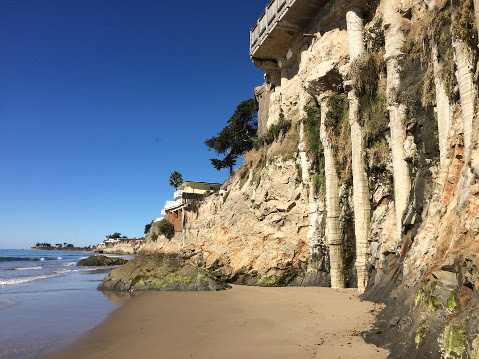King Tides Give Glimpse of Future Sea Level Rise
County Planners Keeping Close Tabs on Accelerating Bluff Erosion

The highest tides of the year, the King Tides, brought the foamy edge of waves near the base of sea cliffs and beachfronts along the Santa Barbara coastline last week. Although the harbor’s breakwater was closed to walkers as a precaution due to high spray, there was no damage reported to the Harbor Patrol.
Nonetheless, the high tides drew a few dozen people to beaches on a grey and sometimes rainy Thursday morning, including environmentalists curious to see what our beaches will look like in decades to come.
“King Tides are interesting because they give us a preview of our future as sea levels rise,” said Mariana Cruz, standing on the beach and watching the tides come over the bottom stair at the concrete steps at Hendry’s Beach. Cruz directs education efforts for Explore Ecology, a Santa Barbara group that teaches schoolchildren about the environment.
“These 8.5 foot high tides give us a glimpse of what our coastline will look like in future decades,” said Penny Owens, standing nearby, who works with the Santa Barbara Channelkeeper. “It really is kind of a looking glass into the effects of sea level rise.”
Patrick Limber, a scientist with the U.S. Geological Survey, who has worked on a team surveying the impacts of waves and storms on Southern California for the past five years, confirmed that the level of the sea is rising and accelerating the retreat of coastal sea cliffs.
“Already you can see the effects on beaches such as Isla Vista,” he said, “There are beaches that are just a little strip of sand. In the future the sea cliffs will retreat much faster.”
Limber said that results compiled by the USGS’s Coastal Storm Modeling System (CoSMoS), using laser measurements of the coastline taken from airplanes every 100 meters, show that this century the sea cliffs will retreat about eight inches a year. That is 175 percent of the historical range for what is called “sea cliff retreat,” and is based on an assumption that the sea level will rise about a meter this century due to global warming. Limber said this was a middle of the road estimate.
Selena Evilsizor, a long range planner with Santa Barbara County, said to plan for rising sea levels and accelerating bluff erosion, the county received a grant of $200,000 from the California State Coastal Commission and $22,000 from the Nature Conservancy in 2014. This included $107,000 for staff time to model the impacts of accelerating bluff erosion on the Santa Barbara coast.
“We now have a state mandate to incorporate coastal hazards such as bluff erosion into our planning efforts,” she said. “We work daily with property owners to ensure public health and safety. According to our costal land use plan, whatever is constructed has to be safe from erosion for at least 75 years.”



